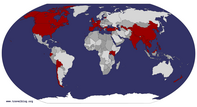Advertisement
Published: June 26th 2014
We join the throngs hurrying along excitedly towards the orange glow emanating from beyond the silhouetted ruins of Angkor Wat to the east. The energy is palpable as it's certain the day is about to open with a spectacular curtain raiser, feeling like a pilgrimage as the throngs narrow in order to a cross a bridge over the moat, heightening the contact, the chatter, the excitement. Entering through a gateway into the main plaza, a long stone causeway stretches away towards the black quincux of towers silhouetted in a pink marbled sky.
A decade previously I crossed this same bridge. Back then, as I entered the main gateway into the main plaza, I took my position amongst the hundreds who already lined the steep banks and outer walls whose cameras feverishly and futilely flashed away into the darkness. And then, despite the spectacular light show unraveling before me, I alone that morning continued walking along the causeway in the dark towards the temple proper. The very reason I remember this event so vividly is because this was my Indiana Jones moment; my attempt to heighten the sense of self-discovery by manufacturing solitude. .
Today, nobody
stops at the outer walls to await the sunrise. Everyone follows one another in charging forth by torchlight over the uneven steps, some led by guides, and pestered by little kids to take breakfast at “number 3” or “number 9, mister!” And in pondering the psychology of crowds, I’m thinking to myself, ‘this isn’t what happened last time.'
.
The fact that the hundreds of tourists who congregate on this dawn-lit morning, hailing from myriad countries around the world - who’ve presumably never previously met - behave differently to the hundreds of tourists who congregated on those dawn-lit mornings years ago, has to have an explanation. In the nine-hundred year lifespan of this temple ten years is a seemingly insignificant timeframe. And yet changes outside the temple complex have been moving at a slightly faster clip.
As we come to the two ponds fronting the temples, we’re ushered by small children and guides to take up residence in the collection of ramshackle restaurants lining the left bank of the left-hand pond. Noodles at 5 am? Plenty of takers for coffee it seems -- quality at this hour seemingly not of paramount importance. Maybe these restaurants
had been there years ago or just weren’t open for business at this hour back then? I don’t remember them.
Sunrise
Tourists take up position along the pond’s shore. The sun has yet to rise, the towers of Angkor sit dimly silhouetted in the reflection of the water, but there are dozens, soon-to-be-hundreds here. As arrivals continue to flood in, the banks of the pond become congested with tourists.
An anthropological observer stumbling across this scene, without any prior knowledge of tourism, might think we are about to share in some sort of postmodern liminalist experience. Pilgrims from all around the world who’ve never previously met are gathering here at dawn to experience a scene long desired and cherished in their collective psyches.
We’re all here to witness the scene we carry with us in our collective minds. That very scene which fills the page when you conduct a Google Images search for “Angkor Wat.”
But the reality of what ensues is not some joyful occasion fuelled by excitement and expectation. These are tourists, not pilgrims, and many are already beginning to show signs of panic. They’ve come
all this way, woken at this ungodly hour, and yet it seems some of them will be denied that experience. That experience, it quickly materializes, is almost entirely linked to the act of them digitally recording
a preordained representation of this scene.
In the time since I was last here Facebook, Twitter, WeChat and iPhones have happened to us, and it is in large part, I believe, because of this, that here this very morning, the narrative has changed.
Merely witnessing the temple with our own senses is not enough, it seems. We’re here on a mission: a mission to photograph, to record, recreate and ultimately share this experience. The temple is bound up in our experience; it is intrinsic to it, and in sharing it we show the world that we have been here. It symbolizes our experience; we are entwined.
It is this act of sharing ad infinitum - this exponential propagation - which has influenced and altered the collective psyche. Honed and refined down through the years, this collective mindset has been mass-ified during the social media big-bang of the last decade.
Those with enviable positions along the pond's edge brace and bolster their positions. As numbers grow, the crowd thickens; the jostling becomes heated and hostile. Tempers begin to fray; sugar levels are low, people’s body clocks have been wound way back, and the cheap granulated coffee hasn’t nearly begun to stabilize the equilibrium yet.
Tourists resent tourists at the best of times. Manifest in statements like "
Though this place is packed with tourists, it's still breathtaking to see." This is not the best of times. A recipe for disaster.
Perhaps the tourists weren’t expecting so many tourists having the exact same idea as them this morning? Or that the demand for getting that shot would lead to such a limited supply of space to capture it themselves? And therein lay one of the many paradoxes. If taken individually these ‘tourist hordes’ are a myriad collection of Korean, Chinese and Japanese tour groups, wealthy middle-age westerners, expats, gap years and those self-defined “travelers” simply manifesting the same idea to see this iconic temple scene, at sunrise, around this pond.
The irony of the tourist horde
is staring at itself in the mirror.
Psychologists will tell you a person’s sense of self can actually be changed if they become part of a group that they consider stigmatized. In other words, if an individual has prejudice against certain group, and then becomes part of this group this prejudice can be turned inward causing depression. If tourists had nothing against tourists they wouldn’t be bothered by them.
But for the anthropologist, the real magic has yet to begin. For despite this dream being so comprehensively dashed by the realities on the ground, that this is the Eiffel Tower of S/E Asia rather than the Lost Ark, it is still evidentially paramount for tourists to frame and crop their photos to reflect the fantasy.
Which brings us to the fundamental paradox: even if we're not in an organized tour group we don't really want to experience this to ourselves. We wish to experience the illusion of experiencing it all to ourselves, so that we can then seek to share that experience with everyone we know. A means of aggrandizing our experience, and ultimately ourselves, to others.
Shutters

 Lara Croft
Lara Croft
Tha Prohm (of course)and flashes blitz in cacophony around the steadily illuminating temple mirrored in the pond, with the sound mirroring the lightening of the sky - the sound of tourists on a postmodern pilgrimage mirroring an image echoing around the world.
A tourist steps out onto a rock in the pond to allow him a privileged angle for his shot, sending ripples across the water, and a wave of disgust through the crowd. He is shouted down by dozens of tourists, heckled into retreat. The atmosphere in the crowd is feverish - desperate!
Indiana Jones
Indiana Jones is a fictional character - a fictional character inspired by the fictional character James Bond - created by George Lucas, the same guy who created the fictional character Chewbacca who was inspired by his real dog Indiana, named after the fictional character Indiana Jones he'd earlier created. Inspired by this was the Tomb Raider series, and the fictional female archaeologist Lara Croft, who was incidentally originally a man, but became a woman because developers believed he too closely resembled Indiana Jones.
To escape the monotony of his dull daily life the fictional character Dr Jones created
“Indiana” himself as “a non-superhero superhero”. This longing in essence is a symptom of our contemporary times and explains the popularity of this character. Unfortunately, this fantasy seems incompatible with all the other Indiana Jones’s and Lara Crofts’ elbowing each other by the side of the pond at dawn that morning.
That image you once saw and now are attempting to recreate to show your friends is just that: an image. We’re living this experience right now. If there were no cameras, if this were my last day on earth, how would I wish to experience this scene? Among a disparate collection of individuals competing in the darkness for a patch of reflection on a pond, or as a collective embracing the dawn of a new day, played out to the backdrop of this spectacular relic of human ingenuity.
As this scene unfolds our kids are huddled at out feet in the darkness. They seem increasingly confused as to why we’ve woken them in the dead of night to come stand by a pond with hundreds of increasingly hostile people. They’re as yet not old enough to understand the complex motivations being played out
in this millennial old ruin in the jungles of Northern Cambodia -- and are becoming palpably freaked out by this absurd turn of events.
Their confused little faces become my catalyst to react, “Embrace it!” I yell, like an evangelizing preacher to the crowd. Heads turn to locate the nutter in the throng.
“What if this was New Years Eve?” I mused.
Then, as I scan across the gloaming at the faces staring back I see a couple of smiles amongst the tense and concentrated expressions directed my way. Just as I’m prepared to climb aboard my soapbox to hammer home the point, a female voice from behind yells out, “You wouldn’t want to be on your own!”
And for a will-o'-the-wisp moment it feels as though we're here experiencing this scene together, as one. Or perhaps it was all in my head?
Climatic conditions conspired to give everyone there that morning the perfect conditions to get that shot, I know I did. And I was happy for it... it's why
I came.
But I wouldn't want to be here when its
raining. Blimey!
Advertisement
Tot: 0.404s; Tpl: 0.017s; cc: 51; qc: 169; dbt: 0.194s; 1; m:domysql w:travelblog (10.17.0.13); sld: 1;
; mem: 1.8mb
































GRACIELA
non-member comment
UNFORGETTABLE
It always reminds me of the so many ONGs who work inside the temples. They work to help disabled children. They do a great work. Those are the most otstanding religious monuments I have ever seen. It´s a great please to get lost inside the monuments. I like your pictures. You can help people while travelling.